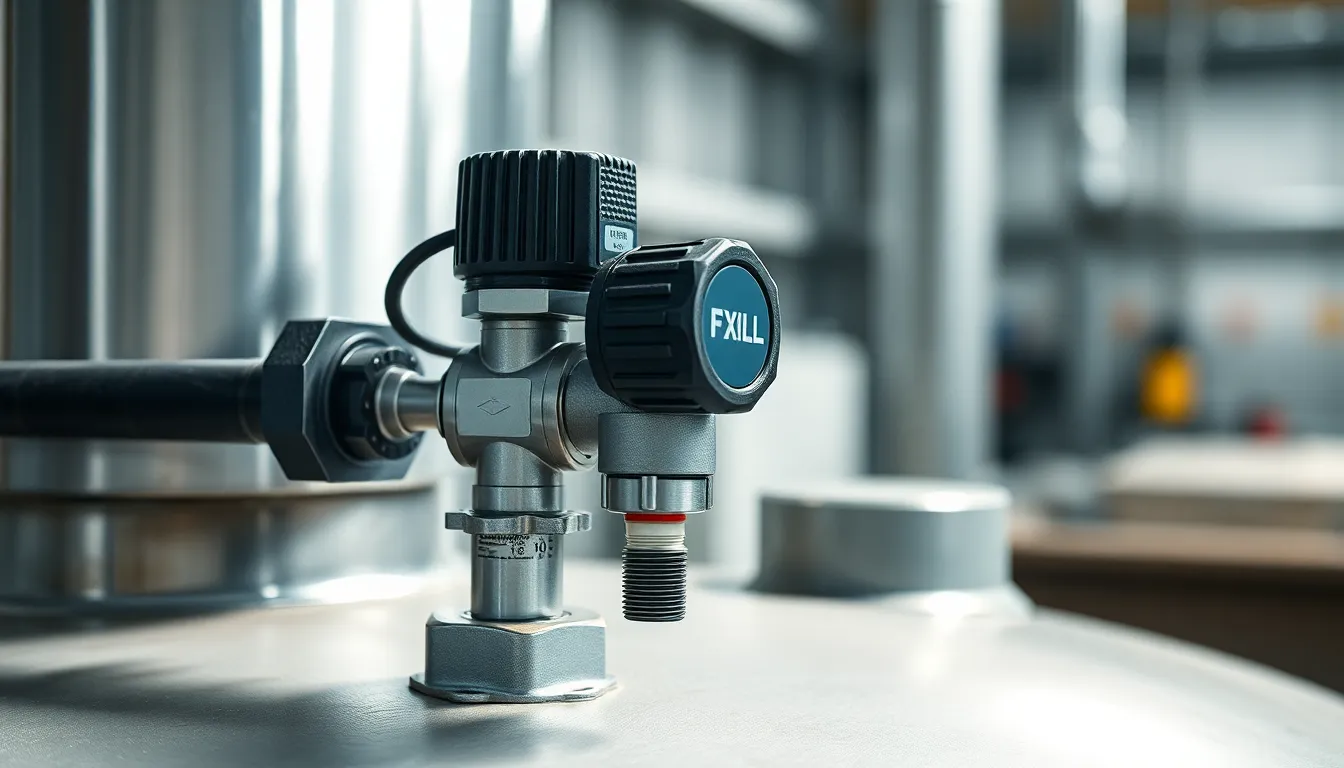In the world of fluid management, efficiency is key. A valve that automatically fills a tank offers a seamless solution to maintaining optimal fluid levels without constant manual oversight. This innovative technology not only saves time but also enhances safety by reducing the risk of overflows or dry runs.
As industries evolve and the demand for automation increases, these valves are becoming indispensable in various applications, from agriculture to manufacturing. They ensure that tanks are filled precisely when needed, allowing for smoother operations and improved productivity. Understanding how these valves work can provide valuable insights into their benefits and applications, making them a crucial component in modern fluid management systems.
Table of Contents
ToggleOverview of Automatic Fill Valves
Automatic fill valves provide a seamless solution for maintaining optimal fluid levels in tanks. These valves operate through various mechanisms, ensuring tanks fill to predetermined levels without manual monitoring.
Functionality of Automatic Fill Valves
- Mechanisms: Automatic fill valves utilize float switches, pressure sensors, or electronically controlled actuators to regulate water flow.
- Activation: Valves activate when fluid levels drop below a set point, allowing immediate refilling.
- Deactivation: Valves close once the desired level is reached, preventing overflow and conserving resources.
Benefits of Automatic Fill Valves
- Efficiency: Automatic fill valves reduce the time spent on manual checks and adjustments, enhancing operational efficiency.
- Safety: These valves minimize risks related to overflows and dry runs, protecting equipment and maintaining fluid availability.
- Versatility: Automatic fill valves find applications across agricultural irrigation systems, industrial processes, and aquaculture facilities.
Key Features
- Adjustable Settings: Users can customize fluid level settings based on specific tank requirements.
- Durable Construction: High-quality materials contribute to the longevity and reliability of valves in various environments.
- Low Maintenance: Automatic fill valves require minimal upkeep, reducing long-term operational costs.
Automatic fill valves play a pivotal role in optimizing fluid management, increasing productivity across multiple industries while ensuring safety and efficiency.
How an Automatic Fill Valve Works

Automatic fill valves operate through precise mechanisms that ensure tanks maintain optimal fluid levels without manual oversight. By employing various technologies, these valves automatically respond to changes in fluid levels, enhancing efficiency and safety.
Mechanism of Action
Automatic fill valves typically use float switches, pressure sensors, or electronically controlled actuators. Float switches detect changes in water levels; when the fluid drops below a defined point, the float activates the valve to fill the tank. Pressure sensors monitor fluid pressure, triggering the valve when pressure dips below a set threshold, indicating low fluid levels. Electronically controlled actuators provide advanced control, responding to specific programming or external controls, allowing for more precise management of fluid input. Each method ensures timely activation and deactivation, preventing overflows and conserving resources.
Types of Sensors Used
Different sensors play crucial roles in the functionality of automatic fill valves:
- Float Switches: Simple and effective, they use a buoyant object to sense fluid level changes. When the level falls, the switch closes the circuit, activating the valve.
- Pressure Sensors: These devices measure fluid pressure within the tank. If the pressure indicates a low fluid level, the system activates the valve for refilling.
- Ultrasonic Sensors: Utilizing sound waves, these sensors measure the distance to the liquid surface, providing real-time data on fluid levels and enabling precise control.
- Capacitive Sensors: These sensors detect changes in capacitance caused by the presence of liquid, allowing for non-contact sensing of fluid levels.
By leveraging these sensors, automatic fill valves enhance reliability and efficiency in fluid management systems.
Advantages of Using Automatic Fill Valves
Automatic fill valves present various advantages, making them a crucial component in fluid management systems across multiple industries.
Time and Labor Savings
Automatic fill valves eliminate the need for manual checks and adjustments, significantly saving time and labor. Operators no longer have to monitor fluid levels constantly, allowing them to focus on other essential tasks. This automation results in reduced labor costs and enhances workflow efficiency. Furthermore, the time saved in filling tanks helps streamline operations, contributing to overall productivity.
Improved Efficiency
Automatic fill valves enhance operational efficiency by ensuring that tanks maintain optimal fluid levels consistently. These valves respond promptly to fluctuations in fluid levels, activating as needed to refill tanks accurately. The use of advanced sensors ensures precise monitoring, minimizing waste and overfilling. Such efficiency not only conserves resources but also extends the lifespan of storage systems, reducing maintenance and replacement costs over time.
Applications of Automatic Fill Valves
Automatic fill valves serve vital roles across various sectors, enhancing efficiency and safety in fluid management. Their applications span industrial and residential settings, demonstrating their versatility and effectiveness.
Industrial Use Cases
Automatic fill valves find extensive use in industrial applications, where precise fluid management is crucial.
- Manufacturing Facilities: These valves maintain consistent fluid levels in processes requiring high accuracy. Industries such as food and beverage leverage automatic fill valves to ensure compliance with health regulations.
- Chemical Processing Plants: Valves prevent chemical spills and leaks, enhancing safety and operational efficiency. They also reduce the risk of contamination by maintaining controlled fluid levels.
- Water Treatment Plants: Automatic fill valves facilitate efficient water level management in treatment processes. They ensure optimal water flow, improving treatment efficiency and reducing operational disruptions.
- Agricultural Applications: Farmers use automatic fill valves in irrigation systems to ensure uniform water distribution. These valves help manage reservoir levels, optimizing resource usage and enhancing crop yields.
Residential Applications
Automatic fill valves also cater to residential needs, providing convenience and resource management.
- Swimming Pools: These valves automatically maintain water levels, preventing evaporation-related issues. They also reduce manual oversight, enhancing pool maintenance efficiency.
- Hot Water Tanks: Valves ensure consistent water levels, improving heating efficiency. This optimization extends the lifespan of hot water systems while reducing energy costs.
- Rainwater Harvesting Systems: In home systems, automatic fill valves manage collected rainwater, ensuring adequate supply during dry periods. This system supports sustainable water use while minimizing manual intervention.
Common Issues and Maintenance
Automatic fill valves, while efficient, may encounter some common issues that can affect their performance. Regular maintenance ensures their longevity and reliability.
Common Issues
- Clogged Filter Screens: Dirt and debris can obstruct filter screens, leading to reduced flow rates. Inspect and clean screens regularly to maintain optimal function.
- Float Switch Malfunction: Float switches may stick or fail, preventing the valve from activating or deactivating as intended. Check float movement and replace faulty components.
- Electrical Failures: Loose connections or defective components in electronically controlled actuators can disrupt operation. Conduct routine electrical inspections to identify and resolve issues promptly.
- Pressure Sensor Errors: Incorrect readings from pressure sensors can cause the valve to operate inefficiently. Calibrate sensors periodically to ensure accuracy.
- Water Hammer: Sudden changes in water flow can create pressure surges, damaging pipes and valves. Install water hammer arrestors to mitigate this effect.
Maintenance Tips
- Regular Inspections: Schedule inspections every six months to identify any wear or damage. Checking for leaks or unusual noises can prevent larger issues.
- Cleaning Procedures: Clean filter screens and sensor surfaces to eliminate buildup. Use gentle cleaning agents to avoid damaging components.
- Adjusting Settings: Ensure that the settings for fluid levels are accurate for the intended application. Regularly reviewing and adjusting these settings can improve efficiency.
- Seasonal Checks: In climates with extreme temperatures, perform seasonal maintenance checks to prepare valves for operational changes, such as winterization procedures.
- Documentation: Keep detailed records of maintenance activities and any issues encountered. This documentation can help identify trends and inform future maintenance strategies.
Automatic fill valves represent a significant advancement in fluid management. Their ability to maintain optimal fluid levels without manual intervention not only enhances efficiency but also promotes safety across various industries. By automating the filling process these valves reduce the risk of overflows and dry runs which can lead to costly damages and operational downtime.
The versatility of automatic fill valves makes them suitable for both industrial and residential applications. With features like adjustable settings and low maintenance requirements they stand out as a reliable solution for fluid management challenges. Regular maintenance ensures their longevity and optimal performance making them a smart investment for anyone looking to streamline their operations and conserve resources. Embracing this technology is essential for modernizing fluid management systems and achieving greater productivity.





